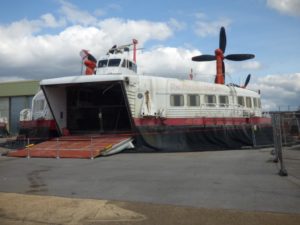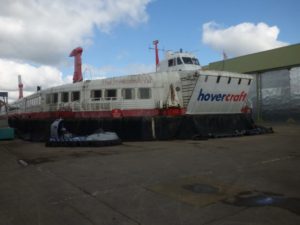
Little and Large at The Hovercraft Museum
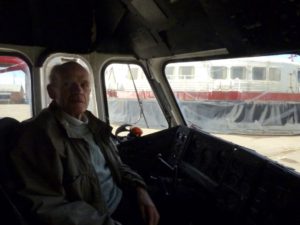
Exceptional man. Retired Hovercraft pilot and museum curator at the controls of his beloved SRN4
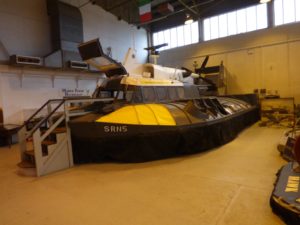 Hovercraft used to be legislated by the CAA but have now transferred to Marine Craft Authority rulings and whilst you stroll around this facility you capture unique examples of craft ranging from personal transport for the Sultan of Brunei through to the craft used in a Pierce Brosnam Bond movie. Examples on display include military examples that have flown to the North Pole to prototypes of proof of concept craft where skills are evolved for future designs. Static displays include plenty of detail of propeller designs including a giant 21-foot example, and an example of a Rolls Royce Gnome engine utilised in the SRN5 (and used in Whirlwind Helicopters).
Hovercraft used to be legislated by the CAA but have now transferred to Marine Craft Authority rulings and whilst you stroll around this facility you capture unique examples of craft ranging from personal transport for the Sultan of Brunei through to the craft used in a Pierce Brosnam Bond movie. Examples on display include military examples that have flown to the North Pole to prototypes of proof of concept craft where skills are evolved for future designs. Static displays include plenty of detail of propeller designs including a giant 21-foot example, and an example of a Rolls Royce Gnome engine utilised in the SRN5 (and used in Whirlwind Helicopters).
One preconception I had that was wrong was that all hovercraft utilised twin engines for both lift and propulsion and ran on jetA1 fuel. This is in fact incorrect. Some ran on diesel and there are examples of current designs being manufactured here that utilise Vauxhall Vectra car engines with air ducted off to fill the skirts from the main fans.
Another little known fact is that the skirts that surround the craft run on very low
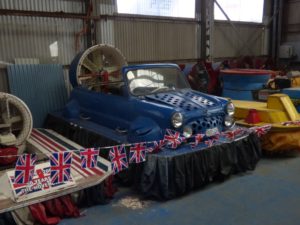
Now that’s what I call a Mini Hovercraft.
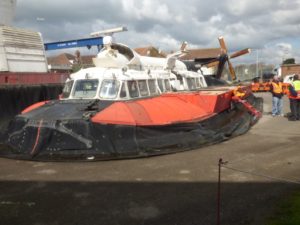 With relatively small runs of build programs over the years, these craft reflect traditional ways of manufacturing and are delightfully carbon fibre free, but did need constant attention to prevent the scourge of corrosion taking hold. Having tried one of these unique craft myself and ticketing information available from the kiosk about Isle of Wight services, I would say its one of those experiences you should all try once, even if they are tremendously noisy.
With relatively small runs of build programs over the years, these craft reflect traditional ways of manufacturing and are delightfully carbon fibre free, but did need constant attention to prevent the scourge of corrosion taking hold. Having tried one of these unique craft myself and ticketing information available from the kiosk about Isle of Wight services, I would say its one of those experiences you should all try once, even if they are tremendously noisy.
This is one of those delightful places where you get to walk through the aircraft and sit at the controls of these intoxicating machines imagining the glamour of high speed travel as you waft across the sea towards the continent. Not wishing to spoil your enjoyment of a thoroughly great day out at very reasonable pricing (£7 for an adult), all I would say is you wont be disappointed should you choose to visit Lee on Solent British Hovercraft Museum. For your GPS Just pop in the postcode PO13 9NY.
More information at www.hovercraft-museum.org. I will return for another visit sometime soon.
Steve Roake
 Hovercraft used to be legislated by the CAA but have now transferred to Marine Craft Authority rulings and whilst you stroll around this facility you capture unique examples of craft ranging from personal transport for the Sultan of Brunei through to the craft used in a Pierce Brosnam Bond movie. Examples on display include military examples that have flown to the North Pole to prototypes of proof of concept craft where skills are evolved for future designs. Static displays include plenty of detail of propeller designs including a giant 21-foot example, and an example of a Rolls Royce Gnome engine utilised in the SRN5 (and used in Whirlwind Helicopters).
Hovercraft used to be legislated by the CAA but have now transferred to Marine Craft Authority rulings and whilst you stroll around this facility you capture unique examples of craft ranging from personal transport for the Sultan of Brunei through to the craft used in a Pierce Brosnam Bond movie. Examples on display include military examples that have flown to the North Pole to prototypes of proof of concept craft where skills are evolved for future designs. Static displays include plenty of detail of propeller designs including a giant 21-foot example, and an example of a Rolls Royce Gnome engine utilised in the SRN5 (and used in Whirlwind Helicopters). With relatively small runs of build programs over the years, these craft reflect traditional ways of manufacturing and are delightfully carbon fibre free, but did need constant attention to prevent the scourge of corrosion taking hold. Having tried one of these unique craft myself and ticketing information available from the kiosk about Isle of Wight services, I would say its one of those experiences you should all try once, even if they are tremendously noisy.
With relatively small runs of build programs over the years, these craft reflect traditional ways of manufacturing and are delightfully carbon fibre free, but did need constant attention to prevent the scourge of corrosion taking hold. Having tried one of these unique craft myself and ticketing information available from the kiosk about Isle of Wight services, I would say its one of those experiences you should all try once, even if they are tremendously noisy.


